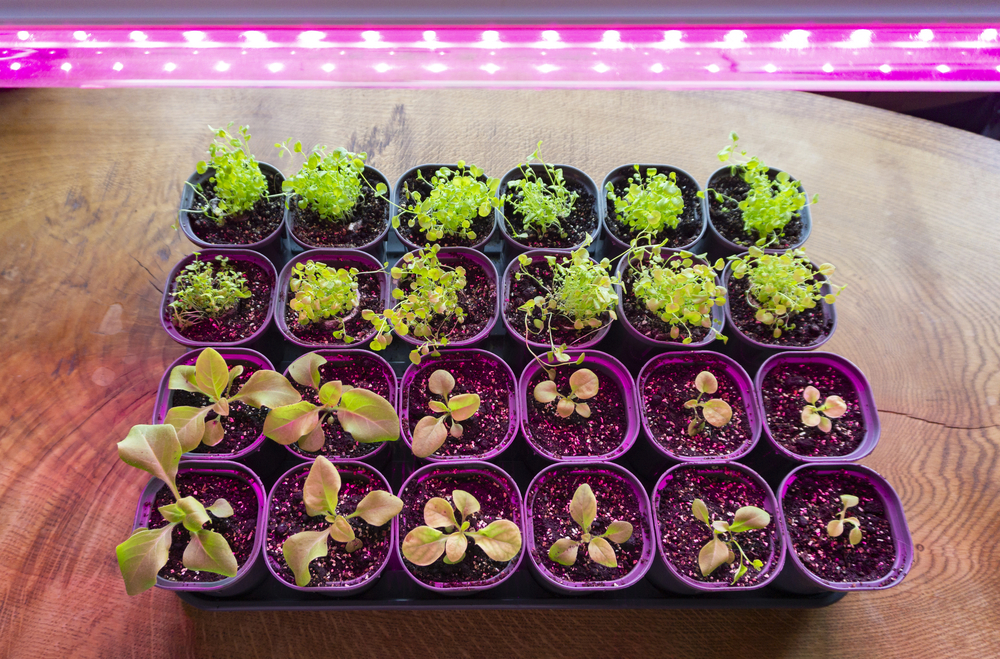Last Updated on February 6, 2023
Light vs darkness. Nature versus technology. Sunlight and LED grow lights are two of the most popular methods for growing plants, but which one is best? We’ll be exploring this age-old debate in our blog post about led grow light vs sunlight: what’s better for your garden? Which has more benefits – natural or artificial lighting? Get ready to compare pros and cons as we dive into the fascinating world of gardening!
Table of Contents:
- Sunlight vs LED Grow Lights: Pros and Cons
- Sunlight: The Natural Choice
- LED Grow Lights: The Artificial Alternative
- Which is Best?
- FAQs in Relation to Led Grow Light vs Sunlight
- Conclusion
Sunlight vs LED Grow Lights: Pros and Cons
Sunlight is the natural source of light for plants, and it’s essential for photosynthesis. Sunlight provides a full spectrum of light that allows plants to grow healthy and strong. However, sunlight isn’t always available or consistent enough to provide optimal growth conditions for some types of plants. That’s where LED grow lights come in.
LED (Light Emitting Diode) grow lights are artificial sources of light designed specifically for plant growth. They emit specific wavelengths of light that can be tailored to meet the needs of different types of plants at different stages in their life cycle.
Pros: Sunlight is free and abundant, so you don’t have to worry about energy costs or running out when growing your own food or flowers indoors or outdoors. It also provides a full spectrum of light which helps ensure healthy growth in all kinds of plants, including vegetables and herbs as well as ornamental ones like flowers and houseplants.

Cons: Unfortunately, sunlight isn’t always reliable – especially during winter months when days are shorter and clouds can block out much-needed rays from reaching your garden beds or indoor planters. Additionally, direct exposure to intense sunlight can cause sunburn on delicate leaves if not properly shielded with shade cloths or other protective measures such as window coverings inside homes with south-facing windows facing too much direct sunshine throughout the day.
Pros: LED Grow Lights offer more control over lighting intensity than natural sunlight does since they’re adjustable via dimmers depending on what type/stage your plant is at in its life cycle; this means less risk for sunburned leaves due to overexposure. LEDs also require less energy than traditional fluorescent bulbs do – perfect for encouraging faster growth rates without having to invest heavily into expensive equipment like HID lamps used by professional growers. Plus they last longer too so you won’t need replacements nearly as often either.
Cons: LED grow lights tend to be pricier upfront compared with regular incandescent bulbs but they’ll save money over time thanks to their long lifespan and low power consumption rate (which means lower electricity bills). Additionally, because these lights only emit certain wavelengths instead of an entire spectrum like natural sunlight does, there may be some deficiencies in nutrient uptake if not supplemented correctly through fertilizers etc.
Sunlight: The Natural Choice
Sunlight is the most natural and affordable way to grow plants. It’s free, it’s always available, and it doesn’t require any additional equipment or energy sources. Sunlight provides essential nutrients for plants that help them thrive in a variety of climates and environments.
The sun’s rays are composed of visible light as well as ultraviolet (UV) radiation, both of which are necessary for photosynthesis – the process by which plants convert sunlight into food energy. UV radiation helps protect plants from disease-causing pathogens while also helping to regulate their growth patterns.
In addition to providing vital nutrition for plant life, sunlight can also be used to control temperature levels within greenhouses or gardens. By using strategically placed windows or skylights, you can ensure your garden receives just the right amount of sunshine throughout the day without overdoing it on hot summer days when temperatures rise quickly.
Finally, there is something calming about watching a garden come alive under direct sunlight; its warmth radiates through every leaf and petal, creating an atmosphere that encourages relaxation and creativity alike. This is something no artificial lighting system could ever replicate quite so perfectly.
LED Grow Lights: The Artificial Alternative
LED grow lights are becoming an increasingly popular choice for gardeners and home growers in the UK. They offer a number of advantages over natural sunlight, such as energy efficiency and controllability.
The main advantage of LED grow lights is their energy efficiency; they use up to 90% less electricity than traditional incandescent bulbs, making them much cheaper to run over time. Additionally, because LEDs produce very little heat compared to other forms of lighting, there is no need for additional cooling systems like fans or air conditioning units – saving more money.
Another great benefit of LED grow lights is their controllability; you can adjust the intensity and duration of illumination depending on what type of plant you’re growing and how much growth you want it to achieve during its life cycle. You can also control when your plants receive light by setting timers so that your crops will get just enough exposure each day without having to worry about manually turning off or on lamps every morning and evening.
Finally, LEDs last up to 10 times longer than traditional bulbs – meaning fewer trips out for replacements. Plus with many models now coming with built-in dimmer switches too, controlling brightness levels has never been easier either.
Overall, it is evident why LED grow lights are becoming a popular alternative choice for UK consumers looking for efficient yet cost-effective ways to cultivate healthy gardens indoors or outdoors.
Which is Best?
When it comes to home and garden products, there are two main options: natural sunlight or artificial lighting. Both have their advantages and disadvantages, so which is best for you?
Cost: Natural sunlight is free, while artificial lighting can be expensive depending on the type of bulbs used. LED lights tend to be more energy efficient than traditional incandescent bulbs, but they also cost more upfront.
Energy Efficiency: Artificial lighting uses electricity to produce light, whereas natural sunlight does not require any additional energy sources. Depending on the type of bulb used in artificial lighting systems, they may use up a lot of electricity compared to natural sunlight.
Convenience: Natural sunlight is available throughout the day as long as there’s no cloud cover blocking it out; however, this isn’t always reliable due to weather conditions or seasonal changes in daylight hours. Artificial lighting systems provide consistent illumination regardless of external factors like time of day or seasonality; however these need to be manually turned off when not needed in order to save energy costs.
Safety: Sunlight has been proven beneficial for mental health and overall wellbeing; however too much exposure can cause skin damage over time if proper protection isn’t taken such as sunscreen or protective clothing items like hats and sunglasses. On the other hand artificial lights don’t pose any direct risks unless they are faulty or malfunctioning which could lead to electrical hazards such as fires or electric shocks if handled improperly by untrained personnel.
If you want an easy-to-use solution with no extra costs then natural light might be your best bet; however, if you’re looking for something that provides consistent illumination without worrying about external factors then an artificial system might suit you better despite its higher upfront cost.
FAQs in Relation to Led Grow Light vs Sunlight
Is sunlight or LED light better for plants?

Sunlight is generally considered to be the best source of light for plants. It provides a full spectrum of light that helps promote healthy growth and flowering. LED lights, on the other hand, can provide an adequate amount of light but may not have all the necessary wavelengths needed for optimal plant health. LEDs also require more energy than sunlight and are usually more expensive in the long run.
Can LED grow light replace sunlight?
Yes, LED grow lights can replace sunlight for indoor plants. They provide the same spectrum of light that natural sunlight does and can be adjusted to match different stages of plant growth. LED grow lights are also more energy efficient than traditional lighting sources, making them a cost-effective option for gardeners looking to save money on their electricity bills. With proper setup and maintenance, LED grow lights can give your plants the light they need to thrive indoors without relying on natural sunlight.
Conclusion
In conclusion, when it comes to growing plants indoors, the decision between using LED grow lights or natural sunlight can be a difficult one. Sunlight is an obvious choice for many as it is free and natural, but LED grow lights are becoming increasingly popular due to their energy efficiency and ability to provide tailored light spectrums. Ultimately, the best option depends on your individual needs and budget – so weigh up the pros and cons of each before making your decision! Whichever you choose, we hope that this guide has helped you understand more about led grow light vs sunlight options available.
Paul is the type of person who never met a problem he couldn’t fix. He can always be found tinkering with something in his house, even if it isn’t broken! His tips and tricks are often shared on our site. He’s the one you call when something breaks because he has been known to improvise fixes for everything from leaky faucets to malfunctioning dryers.

